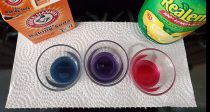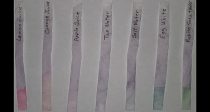This activity has been provided by STEAMfest sponsor MEL Science!”
Step-by-step instructions
Dice some red cabbage and transfer to a 1L beaker. Immerse in hot water and let cool. Filter the mixture. Break and separate a few eggs. Add the red cabbage juice to the egg whites. The egg whites turn bluish-green. Pour the mixture into a preheated frying pan and add salt and pepper to taste. The fried eggs turn out green, but smell and taste quite good!
Process description
Aqueous solutions can be neutral, alkaline, or acidic.
Red cabbage juice has an interesting feature – it contains anthocyanins, which change color depending on the acidity of their medium. Initially, in a neutral medium, cabbage juice has a purple-crimson color. When the cabbage juice is added to the bowl of egg whites, the mixture turns green, as egg whites are an alkaline medium. The pH remains unchanged during the cooking process, and the eggs stay green.
- Did you make the green eggs? What did they taste like?
- Are egg whites alkaline or acidic?
- Can you think of another food that you could turn green with red cabbage juice?
Earn badges and qualify for prize drawing by registering and answering journal questions. It's fun and easy!



